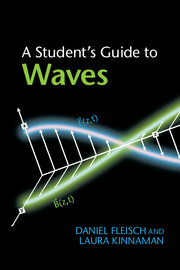4 - The mechanical wave equation
Published online by Cambridge University Press: 05 April 2015
Summary
This chapter is the first of three that deal in detail with the wave equation for three different types of waves. Mechanical waves are described in this chapter, Chapter 5 discusses electromagnetic waves, and Chapter 6 is all about quantum-mechanical waves. You'll find frequent reference in these three chapters to concepts and equations contained in Chapters 1, 2, and 3, so if you've skipped those chapters but find yourself needing a bit more explanation of a particular idea, you can probably find it in one of the earlier chapters.
The layout of this chapter is straightforward. After an overview of the properties of mechanical waves in Section 4.1, you'll find a discussion of two types of mechanical waves: transverse waves on a string (Section 4.2) and longitudinal pressure waves (Section 4.3). Section 4.4 is about energy and power in mechanical waves, and Section 4.5 discusses the reflection and transmission of mechanical waves.
Properties of mechanical waves
We're surrounded by the electromagnetic waves of Chapter 5, and we're made of particles that can be described by the quantum-mechanical waves of Chapter 6, but when you ask most people to describe a wave, they think of the mechanical waves that are the subject of this chapter. That's probably because the “waving” of many types of mechanical waves can be readily observed. For mechanical waves, the waving is done by bits of mass – atoms, molecules, or connected sets of particles, which means that mechanical waves can exist only within a physical material (called the “medium” in which the wave propagates).
For mechanical waves such as a wave on a string, the disturbance of the wave is the physical displacement of matter from the undisturbed (equilibrium) position. In that case, the disturbance has dimensions of distance, and the SI units of the disturbance are meters. In other mechanical waves, such as pressure waves, you may encounter other measures of the wave's disturbance. For example, in sound waves, the disturbance may be measured as the change in the density of the medium or the change in the pressure within the medium from their equilibrium values.
- Type
- Chapter
- Information
- A Student's Guide to Waves , pp. 124 - 161Publisher: Cambridge University PressPrint publication year: 2015



